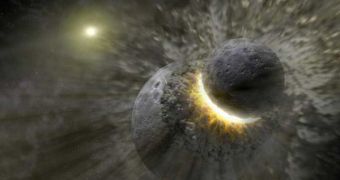According to astrophysicists, the Sun is about 5 billion years old and will continue to shine for at least as much time before exploding into a supernova to destroy the whole solar system. Latest calculations reveal that the inner rocky planets, including Earth, will be destroyed long before the Sun even swells into a red giant star. To be more precise, uncertainties in the orbits of the planets ensure that the solar system will remain stable for only 40 million years, what would happen after that is anybody's guess.
To us humans, it looks like the bodies in the solar system move in a regular manner, each time following the same orbital trajectory. However, theory has thought us gravity doesn't work that way, and has the power to collide or eject planets out of the solar system with the passing of time. Even the smallest gravitational influence may have serious consequences on a long period of time, such as a few tens of millions of years perhaps.
A one to two percent chance today that Mercury would severely alter its orbit in the next 5 billion years could turn into a 100 percent probability in the more distant future. But this is not all: if Mercury were to suffer a destabilization of its orbit, then the whole inner solar system would suffer the consequences, which could lead to catastrophic collisions between Earth and Mercury or Mars. Practically, all life would be destroyed along with our planet.
"In case of such a collision all life gets extinguished immediately, and Earth glows at the temperature of a red giant star for about 1000 years," said co-author of the study, Gregory Laughlin from the University of California.
Mercury goes haywire
Computer simulations of the solar system reveal that, in the long run, Mercury has a one to two percent chance of suffering an orbit alteration due to Jupiter's gravitational pull. Orbital eccentricities (the eccentricity measures the elongation of the orbit of a body, where zero is attributed to an object following a circular trajectory and one to the orbit with the highest possible elongation) could reach up to 0.6 or more, thus increasing the gravitational interactions between the other rocky planets, Venus, Earth, Mars.
Imminent collision
Once Mercury's eccentricity gets up above about 0.6, then it's getting close to crossing Venus' orbit. "Once you get orbit crossings, you sort of transition from the orderly yet chaotic configuration that the solar system is in currently to a much more violently chaotic situation. The all bets are off - a lot of bad things can happen," said Laughlin.
As a result, Mercury and Mars can be easily thrown through the solar system, since their masses are relatively small in relation to those of the Earth or Venus, which is nearly 82 percent of the Earth's mass in comparison with the 6 and respectively 11 percent of the solar system's smallest planets. Again, calculations conducted by Laughlin and Konstantin Batygin, also of UCSC, suggest that Mercury could end up in the Sun less than 1.3 billion yeas into the future, while another scenario shows that Mars could be ejected to the outer regions of the solar system in 820 million years, only to determine a collision between Mercury and Venus 40 million years later.
Aftermath
Practically, what would happen exactly is unknown, however what will occur is anything but good. "You open yourself up to a huge number of possible disasters that can occur. In each case, the gory details are completely different," explains Laughlin.
Earth could collide with either Mars of Mercury, in which case our planet would suffer a similar outcome to the collision which created the Moon 4.6 billion years ago. On the other hand there is the 99 percent probability that the solar system will remain stable for the rest 5 billion years of its life. "The glass is 98 percent full or 2 percent empty," concluded Laughlin.

 14 DAY TRIAL //
14 DAY TRIAL //